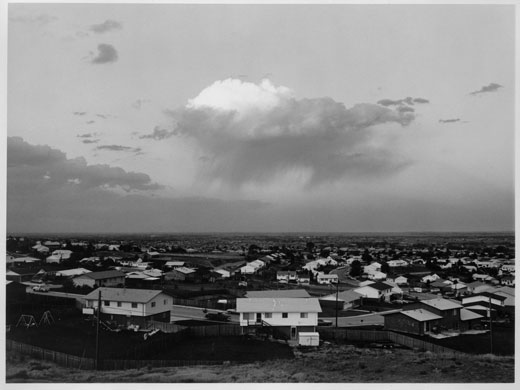
“The Rise and the Fall” Perspectives on the Photography of Robert Adams
Art, Art ShoutsThe Vancouver Art Gallery has been staging a significant exhibition since the 25th of September entitled Robert Adams: The Place We Live, A Retrospective Selection of Photographs. The exhibit showcases over 300 of his pictures spanning the late 1960’s into the early 2000’s. Adams’ work has primarily been recognized for its depiction of western US landscapes and the influence human culture has had on these spaces. Many of the exhibit’s most enduring images are pictures of urban scenes disrupting the earth’s innocence and beauty. This theme runs through the entirety of the exhibit and is contrasted by a number of images of a more pristine subject matter, ultimately seeing the exhibit juxtapose themes of innocence and guilt.
One of the more memorable pictures of the over 300 featured shows a beautiful valley carved out of what looks to be the Rocky Mountain plains. The perspective is not unlike an Ansell Adams photograph. Perched up high, the entire region is visible, we can see the horizon well into the distance and the clouds above create a clear contrast with the murkiness below. Unlike the latter Adams landscapes which suggest a nature in terms of a pure and pristine force as distinct from civilization, Robert Adams’ picture is more sensitive to the powers of our new technologies. The picture features the insidious advance of the said culture appearing poised to overtake and dominate the mountain. The shadows below are revealed to be not just shadows created by the mountainside but by the town’s heavy industry.
Another frequent subject of the exhibit is trees, and a substantial portion of the retrospective is devoted to such images. Depicted are trees in a range of shapes and sizes against a variety of backdrops. What is striking about these images is that the presence of civilization seldom appears to creep into the image in quite the same way as the above picture, giving these images a greater sense of purity. Urban regions are often not present within the frame and a single tree may stand centred against a backdrop of a receding hill and an infinite horizon. Some of Adams’ prettiest pictures are of this kind.
But Adams’ art is never really about purity in itself. Rather, he approaches his subject from the perspective of the pervert, that is, as one who has himself been corrupted by the technological society. Since the camera is a product of the same industrialization it depicts, Adams’ gaze into a beautiful mountainous horizon cannot therefore be considered the gaze of an innocent bystander but must be understood as the gaze of someone who is also the product of the technological culture. As the title of the retrospective suggests, the place we live. It is not just any place, however; the place we live is without a doubt a technological society.
Thus, while Adams brings to our attention the nuances of our complex present, questioning the extent to which it is our own fault, he also appears to suggest that we have been willing to condition ourselves to see in some ways but not others. An image of a tree may conventionally symbolize wisdom or purity or beauty but trees are also the subject of a number of our culture’s founding myths. It has been said that it took the fruit of only one tree to expel Adam and Eve from Eden. Is knowledge thus the problem, or can it offer the solution? Adams appears unwilling to assuredly point us in either direction.
Robert Adams: The Place We Live, A Retrospective Selection of Photographs is at the Vancouver Art Gallery until the 16th of January 2011.
























